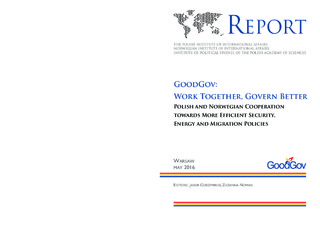| dc.description.abstract | This report presents the main findings of the research project conducted between 2013 and 2016 by the Polish Institute of International Affairs (PISM) and the Norwegian Institute of International Affairs (NUPI), with support from the Institute for Political Studies of the Polish Academy of Sciences (ISP PAN). It also maps the project’s achievements, examines its policy relevance and identifies various knowledge gaps revealed during the study that should be addressed by new research. The GoodGov project has revealed important governance-related differences between Poland and Norway. These result from the interaction of various internal and external factors, including historical experience and path dependence, geographical location and the challenges it poses, various types of resources and access to them, institutional solutions and membership in various international organisations and frameworks. The latter, such as the EU and the EEA, are of special note as they set their own governance-related priorities, rules and solutions that have both a direct and indirect bearing on national governance in Poland and Norway. Based on the analysis of available data, this research project found that the governance system in Norway is perceived as more efficient than in Poland. In addition to the factors mentioned above, this may also be linked to the application of domestic learning mechanisms in Norway, where review of governance and learning play an important role and the apparent lack of such mechanisms in Poland.
Since Norway ranks systematically higher than Poland in all six key categories assessed within the Worldwide Governance Indicators (WGI) project, one could expect the transfer of governance-related knowledge between Norway and Poland to be a possible means of improving governance in Poland, including in the three fields in focus in this study—security, energy and migration. However, the potential for governance learning seems to be hampered by structural differences between Norway and Poland, by the fact that Poland and Norway are in different categories in at least two of the examined fields (energy and migration), and because Norway has decided to remain outside of the EU while Poland is a fully-fledged member. What complicates the picture even more is that the experimentalist approach to governance learning works better in some fields, such as energy and migration, and is much less present and efficient in other governance fields, such as security. Another factor limiting governance transfer is a visible preference for the application of hierarchical, international means of learning instead of nonhierarchical transnational learning practices among professional equals, which is considered to be far more efficient. All the governance-related challenges and differences notwithstanding, Poland and Norway should seek to closely work together for the sake of governance-related improvements. | |

